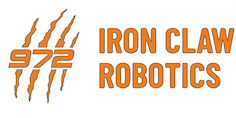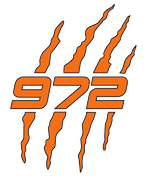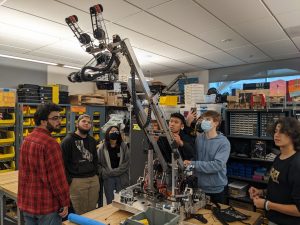 Coming back from Hueneme Port Regionals last week, our team was given the opportunity to observe and learn from other teams by attending an earlier competition. This past week, our team focused on what went well during the competition, as well as how we could improve our robot. After thoughtful consideration and an in-depth discussion, we decided that we would redesign our intake and four bar arm while making minor changes to the elevator. Some of our goals for the upcoming competition are to create faster cycle times for the robot, refine the scouting app, create a more organized pit, fix the bumpers and robot cart, and reconsider our strategy during matches.
Coming back from Hueneme Port Regionals last week, our team was given the opportunity to observe and learn from other teams by attending an earlier competition. This past week, our team focused on what went well during the competition, as well as how we could improve our robot. After thoughtful consideration and an in-depth discussion, we decided that we would redesign our intake and four bar arm while making minor changes to the elevator. Some of our goals for the upcoming competition are to create faster cycle times for the robot, refine the scouting app, create a more organized pit, fix the bumpers and robot cart, and reconsider our strategy during matches.
For the intake, we aimed to create a larger acquisition zone and more reliable cone storage and intake. The team created a horizontal roller design similar to the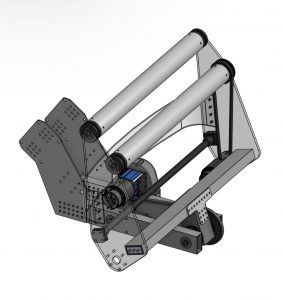 one used by team 1678 Citrus Circuits, which would increase the acquisition area and carry the game piece more securely. In addition we changed the motors for the wrist and intake to Falcon 500s to reduce wiring clutter. The intake uses two 2” dead axle intake rollers and a polycord gear reversal to intake both cones and cubes consistently. We are wrapping the rollers with self sealing silicone tape to ensure that the intake can grip the game pieces.
one used by team 1678 Citrus Circuits, which would increase the acquisition area and carry the game piece more securely. In addition we changed the motors for the wrist and intake to Falcon 500s to reduce wiring clutter. The intake uses two 2” dead axle intake rollers and a polycord gear reversal to intake both cones and cubes consistently. We are wrapping the rollers with self sealing silicone tape to ensure that the intake can grip the game pieces.
We also wanted to revise the four bar arm so that it has a simpler mechanical design with less backlash. Our solution was a wrist similar to our team’s arm mechanism during the 2022 season. The wrist simplifies the design to one pivot point and improves rigidity of the whole robot. After witnessing 973 toss cubes into the community during the beginning of teleop, we geared the wrist to allow cube throwing. Moving forward we hope to test and implement cube throwing as a potential strategy after our programmers refine the code for the updated mechanisms.
Finally, to revise the elevator, we wanted to reduce the clutter and weight of the energy chain by replacing the three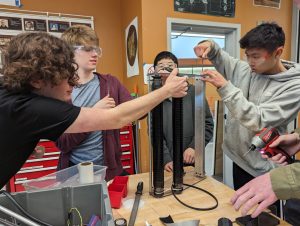 Neos with two Falcon 500 motors and by relocating the bottom limit switch sensor. By changing the motors, we halved the size of the cable tray and removed the Spark MAX motor controllers from the robot entirely. Although we first leaned towards Neos at the beginning of the season due to the Falcon 500 shortage, we are beginning to realize the versatility and ease of use of the Falcon motors.
Neos with two Falcon 500 motors and by relocating the bottom limit switch sensor. By changing the motors, we halved the size of the cable tray and removed the Spark MAX motor controllers from the robot entirely. Although we first leaned towards Neos at the beginning of the season due to the Falcon 500 shortage, we are beginning to realize the versatility and ease of use of the Falcon motors.
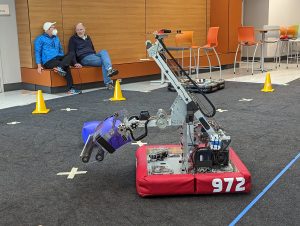 Overall, this week has been a busy one for the team as we prepare for San Francisco Regional next week. The manufacturing team has worked on machining parts for the redesigned game piece manipulator and the programming team is working on refining their autonomous routines, decreasing cycle times for the robot, and implementing odometry and vision to assist our driver in teleop. We are also continuing lots of driver and operator practice to ensure that the drive team is prepared. We look forward to competing at SFR this coming weekend and wish the best of luck to the other teams attending!
Overall, this week has been a busy one for the team as we prepare for San Francisco Regional next week. The manufacturing team has worked on machining parts for the redesigned game piece manipulator and the programming team is working on refining their autonomous routines, decreasing cycle times for the robot, and implementing odometry and vision to assist our driver in teleop. We are also continuing lots of driver and operator practice to ensure that the drive team is prepared. We look forward to competing at SFR this coming weekend and wish the best of luck to the other teams attending!
Student Interview:
Senior Emi Hiroshima is the Manufacturing Lead for Iron Claw Robotics. As Manufacturing Lead, Emi has played an integral role in the training, coordination, and operation of the machine shop and has enabled the team to greatly expand its manufacturing limits.
coordination, and operation of the machine shop and has enabled the team to greatly expand its manufacturing limits.
Emi joined robotics in her sophomore year because she was looking for an opportunity to explore engineering at LGHS and “robotics seemed like the best option”. Robotics provided a project based structure for an exploration into engineering which resonated with Emi the most. Through her three years on the team, she cherishes the friendly atmosphere and the friendships she’s built through the team, particularly because of the tight teamwork required to create, test, and compete with a robot.
Emi identified learning CNC machining as another great takeaway from robotics and feels empowered through becoming familiar with industrial-grade machines. She recommends robotics for students who are interested in engineering, advising that the ability to insert yourself and take initiative to learn by oneself is extremely valuable.
